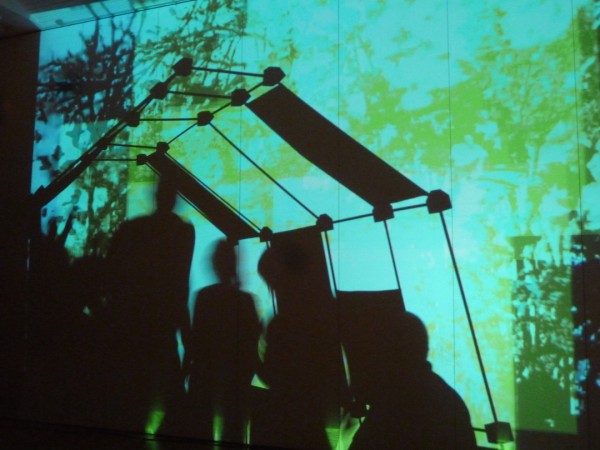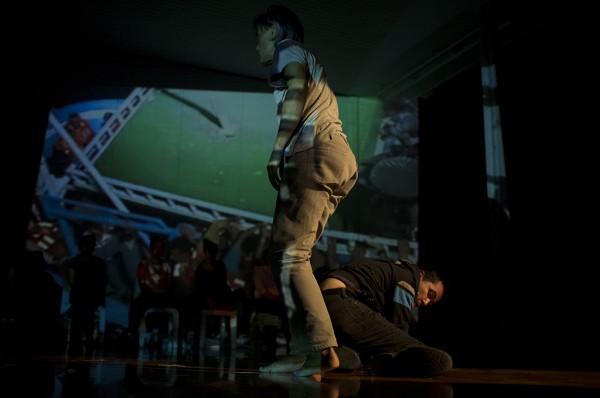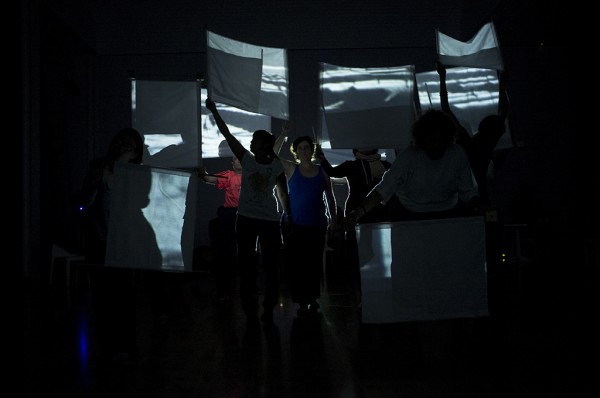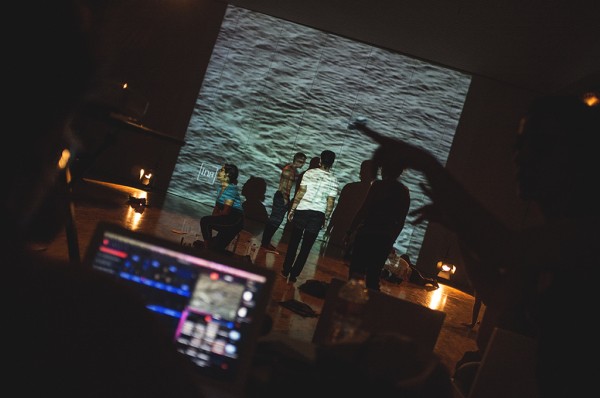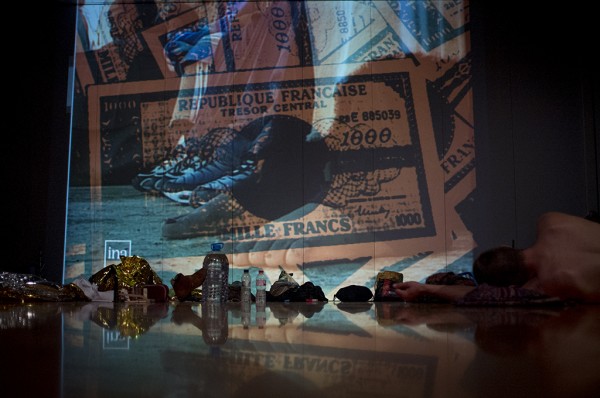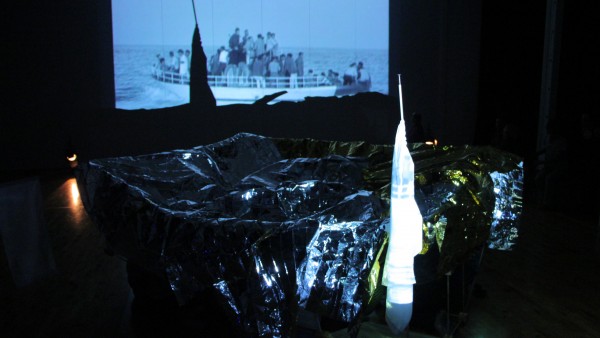Artistic experiences - process
Collective creation workshop about the use of archive images in the performing arts
Place of the workshop:
Factory Artistic Creation, Fabra I Coats, Barcelona.
Partners Involved:
 Lieux Fictifs (FR)
- Caroline Caccavale, filmmaker
- Joseph Césarini, filmmaker
- Thierry Thieû Niang, choreographer
- Christophe Beckers, dancer
 transFORMAS (ES)
- Thomas Louvat, theater director
- Guillem llotje, technical coordinator
- Non Ten Xeito, video artist
- Eva GarcÃa, director of transFORMAS
- Roger Lapuente, filmmaker
Audiences and Territories:
Paloma Casa, Yazel Parra, Natalia Carpintero, Marina Correa, Judit Costa, Yolanda de las Heras, Pilar Soler, Carlos Ruiz, Chen, Cristina Pérez, Joan Vidal, Teresa petit, Emanuel Alejos, Carolina Torres, Lara Nuñez, Francisco Bagliatello, Esperanza Rodriguez, Joana Herance, Carlota Gerlonch.
Participants are people interested in the project transFORMAS without any previous theatrical training requirement. These are people of all ages, neighborhood equipment users or members of associations of the district. Specifically, people who participated at the workshop came from:
- Casal de Navas: retired people
- Equipment integral Meridiana: people living in the street
- AREP: Association for the rehabilitation of persons with mental illness
- AFAP: Association for helping people with poliomyelitis
- FORA’m: permanent group of theatrical creation of transFORMAS: Barcelona residents and periphery
Archives used:
Files of the INA (National Audiovisual Institute of France) were used. They were selected 22 minutes from four categories of images:
– Displacement of people: immigrants, refugees, boat people
– People running: marathon, fun run, single race and / or collective
– Money: bank note printing, destruction of banknotes, banknote distribution
– Moving Landscapes: sea, birds
Methodology:Â
TransFORMAS has opted for years to do a theater to include and make visible differences and difficulties – and the conflict that causes- but not intended necessarily to include anyone in anything.
It is not the function of theater give answers but to ask as openly as possible over the cracks – the contradictions that form in the ways of doing everyday.
From this point of view, what could be residual for other theaters as the limitations, obstacles, problems become the subject of work for this way of doing.
Somehow, a theater “in” and “between” the difference has needed to include the public and collective memory as an active element of the process. The collective ideology of a community, a people’s memory as images o archives become actors in the play and integral parts of the creative process.
If the archive can be associated with the collective memory selected, trapped itself with the generation of group identity, making theater from the metaphor of the archive is playing with the dynamics of identity, memory, individual and collective. Play with archive and with the implications that entails is to play with the metaphor of the collective identity and identity cracks on the community and on the individual. What it remains fixed but also excluded, what it says but also what it means and what it denies. The archive, in this theater, is another actor and a language and a metaphor for the identity, the collective and the individual, the nuclear and the peripheral.
The main steps are:
- Passive Viewing: Observe all material without any previous idea. We’ll see what happens.
- Active Viewing: We have a preconceived idea about the performing arts, the concept that we are working and we will search for images that come into direct dialogue with our idea.
- Editing images: The possibility of reconstructing the material creating new forms, narratives and rhythms to make our own archive and give other senses.
These images are projected on scenography with multiple screens and multiple forms with the intention not only to project the video but also to incorporate it as part of the installation stage, where actors can interact with them, and the viewer will have a transformed vision of the original archive image.
- Improvisation actor with archive footage. Physical dimension of the relation between body and image archive.
It works using different techniques:
- Mixing: Mix different videos, with the possibility of changing the color, shape, saturation, etc ..
- Mapping: Projecting images on a multiscreen adapted projection space
- Interactive video: ability to modify the video through the movement of the actor
- Looping: creation and repeat loops
We have designed a flexible scenic device that fits the context. It consists of several wooden slats, connecting nodes and screens that participants can use freely.
This process of working with the different elements is carried out in the context of training in theatrical techniques: preparation of the actor, group cohesion and collective creation based on improvisation techniques.
With this process we seek to create a space for collective creation where participants explore the relationship between archival footage and theatrical creation, incorporating technical elements of video and performing arts.
Furthermore, the workshop addresses transversely basic elements associated with the work of the actor and shared creation. The contents of archives allow playing, observing different views of the same element in both cultural diversity, artistic taste, or in history.
Creating a horizontal space: Everyone has the same weight to make decisions, only differ from previous experience. In this sense, it is from the argument of the decisions and the process that one single idea makes sense collectively, being the prevailing and best idea for the group.
Lugar del workshop:
Fábrica de creación Fabra I Coats, Barcelona.
Socios involucrados:Â
Lieux Fictifs
- Caroline Caccavale, realizadora
- Joseph Césarini, realizador
- Thierry Thieû Niang, coreógrafo
transFORMAS
- Thomas Louvat, director teatral
- Guillem Llotje, coordinador técnico
- Non Ten Xeito, vÃdeo artista
- Eva GarcÃa, directora transFORMAS
- Roger Lapuente, documentalista
Públicos y territorios:
Francia: Christophe Becker
España: Paloma Casa, Yazel Parra, Natalia Carpintero, Marina Correa, Judit Costa, Yolanda de las Heras, Pilar Soler, Carlos Ruiz, Chen, Cristina Pérez, Joan Vidal, Teresa petit , Emanuel Alejos, Carolina Torres, Lara Nuñez, Francisco Bagliatello, Esperanza Rodriguez, Joana Herance, Carlota Gerlonch.
Los participantes son ciudadanos sin experiencia artÃstica previa del distrito de San Andreu y otras áreas de Barcelona interesados en el proyecto de transFORMAS. El grupo integra a personas de edades diferentes, usuarios de los equipamientos públicos o de entidades del distrito. Concretamente, los participantes del workshop vienen de:
- Casal de Navas: personas jubiladas
- Equipamiento integral: personas sin techo
- AREP: personas con enfermedades mentales
- AFAP: personas con discapacidad fÃsica (poliomielitis)
- FORA’m: grupo permanente de creación teatral de transFORMAS: ciudadanos de Barcelona y periferia.
Archivos utilizados:
Se utilizaron archivos de l’INA, Instituto Nacional del audiovisual de Francia. Se seleccionaron 22 minutos a partir de cuatro categorÃas de imágenes:
- Desplazamiento de personas: inmigrantes, refugiados, boat people
- Gente corriendo: maratón, carrera lúdica, carrera individual i/o colectiva
- Dinero: impresión de billetes del banco, destrucción de billetes, distribución de billetes
- Paisajes en movimiento: mar, pájaros
MetodologÃa:
TransFORMAS ha optado desde años por hacer un teatro que incluya y haga visibles las diferencias y dificultades – y el conflicto que provocan- pero que no pretenda, necesariamente, la inclusión de nadie en nada.
No serÃa función del teatro dar respuestas sino preguntar de la forma más abierta posible sobre las grietas – las contradicciones- que se forman en los modos de hacer cotidianos.
Desde este punto de vista, aquello que podrÃa resultar residual y eliminable para otros teatros tal como las limitaciones, los obstáculos, los problemas se convierten en la materia de trabajo para esta forma de hacer.
De alguna forma, un teatro “en†y “entre†la diferencia ha necesitado incluir al público y su memoria colectiva como elemento activo del proceso. El ideario colectivo de una comunidad, la memoria de un pueblo en forma de imágenes o archivo se convierten en actores de la obra y partes integrantes del proceso creativo.
Si el archivo puede tener que ver con la memoria colectiva seleccionada, atrapada en sà misma, con la generación de identidad de un grupo, hacer teatro desde la metáfora del archivo es jugar con las dinámicas sobre la identidad, la memoria, lo individual y colectivo. Jugar con el archivo y con las implicaciones que comporta es jugar con la metáfora sobre la identidad colectiva y con las grietas que esa identidad genera en la comunidad y el individuo. Lo que queda fijado pero también excluido, lo que dice pero también lo que implica y lo que niega. El archivo, en este teatro, es un actor más y un lenguaje y una metáfora sobre la identidad, sobre lo colectivo y lo individual, sobre lo nuclear y lo periférico.
En el marco de este workshop, se utilizan imágenes de archivo televisivo.
La etapas principales son:
- Visionado pasivo: Observar todo el material sin ninguna idea previa, a ver qué nos pasa.
- Visionado activo: Tenemos una idea previa sobre la creación escénica, sobre el concepto que estamos trabajando y vamos a buscar imágenes que entran en diálogo directamente con nuestra idea.
- Edición y montaje de las imágenes: La posibilidad de reconstruir el material creando nuevas formas, narraciones o ritmos para hacer nuestro propio archivo y darle otros sentidos.
Estas imágenes las proyectamos en una escenografÃa con múltiples pantallas de múltiples formas con la intención no sólo de proyectar el vÃdeo sino también de incorporarlo como parte de la instalación escénica, donde los actores podrán interactuar con ellas, y el espectador tendrá una visión transformada de la imagen de archivo original.
- Improvisación del actor con las imágenes de archivo. Dimensión fÃsica de la relación entre cuerpo e imagen de archivo.
Se trabaja a partir de diferentes técnicas:
- Mixing: mezclar diferentes vÃdeos, con posibilidad de modificar el color, la forma, la saturación, etc..
- Mapping: Proyección de imágenes en multipantalla adaptadas en un espacio de proyección
- VÃdeo interactivo: capacidad de modificar el vÃdeo a través del movimiento del actor
- Looping: creación y repetición de loops
Hemos diseñado un dispositivo escénico flexible y adaptable al contexto. Consiste en varios listones de madera, nudos de conexión y pantallas que los participantes pueden utilizar de manera libre.
Este proceso de trabajo con los diferentes elementos se realiza en un contexto de formación en técnicas teatrales: preparación del actor, cohesión de grupo y creación colectiva basada especialmente en técnicas de improvisación.
Con este proceso buscamos generar un espacio de creación colectiva donde los participantes exploren la relación entre las imágenes de archivo y la creación teatral, incorporando elementos técnicos y profesionales del vÃdeo y las artes escénicas.
Por otro lado, la formación aborda de manera transversal elementos básicos asociados al trabajo del actor y a la creación compartida. El contenido de los archivos ha permitido poner en juego, observar diferentes miradas de un mismo elemento tanto en la diversidad cultural, el gusto artÃstico, o en la historia.
Creación de un espacio horizontal: Todo el mundo tiene el mismo peso para tomar decisiones, sólo difieren en las experiencias previas. En este sentido, es a partir de la argumentación de las decisiones y del proceso que una idea individual toma fuerza de manera colectiva, siendo la que prevalece en el tiempo la mejor para el grupo.
